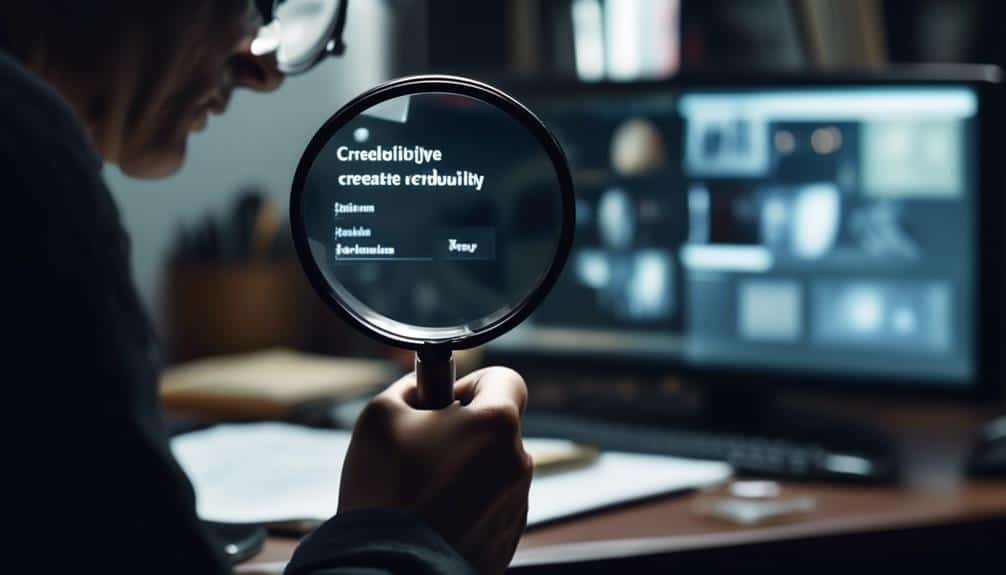Evaluating Credibility: Research Tools for Fact-Checking and Source Verification
When navigating the vast sea of information online, separating fact from fiction can feel like finding a needle in a haystack. In a world where misinformation can spread like wildfire, having the right tools at your disposal becomes paramount.
From search engine verification techniques to bias detection methods, there are numerous resources available to assist you in evaluating credibility. Each tool offers a unique perspective on vetting sources, ensuring you can make informed decisions.
Key Takeaways
- Domain authority assessment is crucial for verifying information source credibility.
- Bias detection is essential for critically evaluating sources and content accuracy.
- Multimedia verification tools play a significant role in ensuring authenticity.
- Cross-referencing data and analyzing domain trustworthiness are essential for ensuring online information reliability.
Importance of Credibility Evaluation

Evaluating the credibility of sources is a crucial step in ensuring the accuracy and reliability of information in the digital age. Credibility assessment is key to separating fact from fiction and making informed decisions. In today's fast-paced world, where information spreads rapidly, it's essential to verify the authenticity of sources before accepting them as truth. Source validation involves examining the expertise, trustworthiness, and bias of the provider to determine if the information can be relied upon.
To enhance credibility assessment, utilize innovative tools such as digital verification platforms, fact-checking websites, and data analysis software. These tools can help you cross-reference information, detect misinformation, and gauge the accuracy of sources quickly and efficiently. By incorporating these technologies into your research process, you can ensure that the information you rely on is credible, up-to-date, and trustworthy.
Search Engine Verification Techniques
When verifying sources, conducting a domain ownership check can reveal crucial details about the website's legitimacy.
Additionally, analyzing cached pages can help you determine if content has been altered or removed.
These search engine verification techniques are essential in ensuring the reliability of information you encounter online.
Domain Ownership Check
To effectively verify the ownership of a domain, you must utilize search engine verification techniques that provide reliable and accurate results. One of the most common methods is conducting a WHOIS lookup, which allows you to access information about the domain's registration details.
By entering the domain name into a WHOIS lookup tool, you can retrieve data such as the owner's name, contact information, registration date, and expiration date. This ownership verification process is crucial for fact-checking and ensuring the credibility of a website.
Additionally, cross-referencing this information with other sources can help confirm the legitimacy of the domain and the content it hosts. By using these search engine verification techniques, you can establish the authenticity of a website and its ownership with confidence.
Cached Page Analysis
By analyzing the cached pages of a website, you can further verify its credibility and ownership through search engine verification techniques. This method allows you to delve deeper into the page integrity and content accuracy.
Here are some key points to consider:
- Temporal Changes: Examining cached pages can reveal any alterations made over time, aiding in assessing the consistency and reliability of the content.
- Ownership Confirmation: Verification through cached pages can help confirm the website's ownership details and history, providing insights into its legitimacy.
- Comparative Analysis: Contrasting current pages with cached versions can highlight discrepancies, enabling a more thorough evaluation of the site's trustworthiness in terms of content accuracy.
Social Media Analysis Tools

Effective fact-checking and source verification in the digital age often necessitates utilizing specialized social media analysis tools. Social media analysis tools offer a way to monitor and analyze online conversations, providing valuable insights for fact-checking and source verification. Two key functionalities of these tools are social listening, which involves tracking mentions and discussions related to a specific topic, and sentiment analysis, which helps in understanding the attitudes and emotions expressed in social media posts. By harnessing these tools, fact-checkers can sift through vast amounts of data to identify misinformation, verify sources, and assess the credibility of information circulating on social media platforms.
| Social Media Analysis Tools | Description |
|---|---|
| Social Listening | Tracks mentions and discussions on specific topics |
| Sentiment Analysis | Analyzes attitudes and emotions in social media |
Domain Authority Assessment
When evaluating domain authority, consider factors like the website's trustworthiness and credibility. Assess the authority evaluation criteria to determine the reliability of the source.
Understanding domain authority is crucial for verifying the credibility of information sources.
Domain Trustworthiness Analysis
Analyzing the trustworthiness of a domain through Domain Authority Assessment is essential to evaluate the credibility and reliability of online sources.
When conducting a Domain Trustworthiness Analysis, consider the following:
- Consistency: Look for domains that consistently provide accurate and up-to-date information to ensure reliability.
- Transparency: Seek domains that are transparent about their sources and methodology, fostering trust among users.
- Authority: Prioritize domains with a strong reputation and expertise in their respective fields, enhancing credibility.
Authority Evaluation Criteria
To assess the authority of a domain effectively, consider evaluating its Domain Authority score alongside other key metrics. Source reliability and expertise assessment are crucial factors in determining the credibility of a website.
Authoritative sources and credibility indicators play a significant role in establishing a domain's trustworthiness. When evaluating a website, look for clear indications of the author's qualifications and expertise in the subject matter. Assess whether the information provided is supported by reputable sources and if the content aligns with established facts.
Additionally, examine the website's overall reputation and track record for accuracy. By considering these authority evaluation criteria, you can make informed decisions about the reliability of the information presented on a particular domain.
Fact-Checking Websites and Platforms

Fact-checking websites and platforms offer a valuable resource for verifying information and ensuring the accuracy of sources in today's digital age. These platforms play a crucial role in helping individuals navigate the vast sea of online content by providing reliable fact-checking services.
Here are some key points to consider when utilizing fact-checking websites:
- Instant Verification: Fact-checking websites offer real-time updates, allowing you to quickly verify information before sharing it.
- Diverse Perspectives: These platforms often present information from various sources, providing a more comprehensive view of the topic at hand.
- Educational Tools: Fact-checking websites not only validate sources but also educate users on how to critically evaluate information independently.
Bias Detection Methods
In navigating the realm of online information, honing your ability to detect bias becomes essential for critically evaluating sources and ensuring the accuracy of the content you encounter. To aid in this process, bias detection algorithms have been developed to analyze articles and websites for potential biases. These algorithms use various indicators to assess the credibility of a source, such as the language used, the framing of arguments, and the consistency of information presented. By incorporating credibility scoring, these algorithms can provide users with a quantitative measure of how reliable a source may be.
In addition to bias detection algorithms, context analysis plays a crucial role in identifying biases. Source reliability indicators, such as the publication's history of accuracy and any affiliations it may have, are essential factors in determining the potential for bias. By examining the context in which information is presented, individuals can better understand the underlying motivations or agendas that may influence the content they consume. By combining bias detection algorithms with thorough context analysis, you can enhance your ability to discern credible sources from biased or misleading ones in the vast landscape of online information.
Cross-Referencing Resources

Utilize a systematic approach to cross-referencing various resources to verify information accuracy and enhance the reliability of your research findings. When engaging in the verification process, it's crucial to compare the credibility of different sources to ensure the validity of your information.
Here are three key ways to enhance your cross-referencing techniques:
- Diversify Your Sources: Incorporate a wide range of resources, including scholarly articles, reputable websites, and expert interviews to gain a comprehensive understanding of your topic.
- Check Consistency: Look for consistency in facts, figures, and data across different sources. Inconsistencies may indicate inaccuracies or biases that need further investigation.
- Evaluate Author Expertise: Assess the authority and expertise of the authors or organizations behind the information. Qualified and reputable sources are more likely to provide accurate and reliable data.
Image and Video Verification Tools
To enhance the verification process and ensure the authenticity of multimedia content, exploring specialized tools for verifying images and videos is essential. When it comes to image verification, utilizing a reverse image search tool can be highly effective. Platforms like Google Images or TinEye allow you to upload an image or input its URL to find instances of where else that image appears online. This can help in determining the original source or identifying potential manipulations.
On the other hand, with the rise of deepfake technology, it has become crucial to employ deepfake detection tools to combat the spread of misleading or falsified videos. These tools use algorithms to analyze videos, detecting inconsistencies in facial expressions, voice patterns, or other anomalies that could indicate the presence of deepfakes.
Frequently Asked Questions
How Can One Effectively Evaluate the Credibility of a Source That Is Not Easily Verifiable Through Traditional Search Engine Techniques?
When evaluating a source that's challenging to verify using standard search methods, consider expert interviews and data analysis. Cross-referencing and content analysis can also be valuable in confirming the credibility of such sources.
Are There Any Specific Social Media Analysis Tools That Are More Reliable Than Others for Verifying the Credibility of Sources?
When assessing credibility through social media analytics, consider tools like CrowdTangle for tracking engagement, Hoaxy for detecting misinformation spread, and Botometer for identifying automated accounts. Each offers unique features for comprehensive credibility assessment.
How Can One Assess the Credibility of a Website Based on Its Domain Authority Alone?
To assess the credibility of a website based on domain authority alone, look for established domains with high trustworthiness. Evaluate the domain's history, content quality, and backlinks. Domain credibility is a key factor in assessing reliability.
What Are Some Lesser-Known Fact-Checking Websites and Platforms That Are Useful for Verifying Information?
Explore lesser-known fact-checking websites and platforms. Crowd-sourced platforms offer diverse perspectives. Alternative search engines reveal hidden gems. Expert opinions provide depth. Multimedia analysis enhances understanding. Embrace innovation to verify information effectively.
How Can Bias Detection Methods Be Effectively Applied When Cross-Referencing Different Resources for Credibility Evaluation?
When cross-referencing for credibility, apply bias detection methods effectively. Verify sources meticulously and use diverse perspectives. By scrutinizing inconsistencies and patterns, you can enhance the accuracy of your assessments and make more informed judgments.
Conclusion
In conclusion, when evaluating credibility, utilizing a combination of research tools is crucial. These tools include search engine verification techniques, social media analysis tools, domain authority assessment, fact-checking websites, bias detection methods, cross-referencing resources, and image and video verification tools.
By incorporating these tools into your fact-checking and source verification process, you can ensure that the information you rely on is accurate, trustworthy, and reliable. Stay vigilant in your pursuit of truth and always verify your sources.








